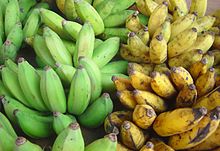Banana market organization



The banana market organization (also: common market organization for bananas , GMO) is part of the agricultural market regulations of the European Union within the framework of its agricultural policy. Its main regulations are determined in particular by EC regulations 404/93 and 1442/93 .
background
The market organization in the banana sector was introduced in 1993 to counter the bananas produced in Spain (especially in the Canary Islands ) and in various former French colonies overseas against imports from the growing areas in South America and Central America, which are mainly dominated by US multinational companies to make it competitive. In Germany, before the banana market regulation was enacted, bananas from third countries were particularly widespread on the uncontrolled market, as Community and ACP bananas were not competitive with them in terms of price and quality.
The banana market organization distinguishes between
- Community bananas (= origin from member states of the European Community )
- ACP bananas (= origin of the so-called ACP countries , which are countries from A frica, the K aribbean and the P azifikraum, mostly former colonies of France and Britain, which in the Lomé Convention have joined) and
- Third country bananas (= other origins).
Control mechanism
The banana market regulation uses three levers to regulate the market:
- Firstly, the existing production of Community bananas is supported by subsidies .
- Second, the sale of “traditional ACP bananas” was only made possible by the exemption from import duties . The term “traditional ACP bananas” refers to ACP bananas within a certain import quota that is intended to correspond to the “traditional sales” from these countries. This formulation paraphrases that the market support should not result in a massive expansion of imports from the ACP states, as this would have led to clear protests among consumers due to the lower quality.
- Thirdly, higher levies (import duties) were introduced for non-traditional ACP bananas and third-country bananas above specified import quotas . Imports that are within the first quota (the first x tonnes of bananas which are imported in one year) are subject to a low levy, bananas that are within the next quota (more than x tonnes of bananas, but not yet y tonnes of bananas ) are subject to a higher levy. All imports in excess of these quotas will be charged the full levy. The respective quotas were divided among the importers by means of import licenses .
consequences
As a result of the regulations, on the one hand, the prices for bananas from third countries are higher than the prices for Community and "traditional" ACP bananas. Second, they resulted in huge quantities of bananas being declared for free circulation on the first working day of each year and the quota being exhausted at the very beginning of the year.
Several importers of third-country bananas initially went to the European courts against the market regulations. In the second instance, however, they were finally rejected. Despite the introduction of the market organization for bananas, the dominance of the US banana multinationals on the European market has not yet been broken. So is z. B. in Germany Chiquita remains the market leader.
See also
Web links
- Summary of the regulations of the common organization of the market in bananas , with links to the full texts
- Market organization for bananas , Federal Agency for Agriculture and Food
- Press release of the Federal Constitutional Court
